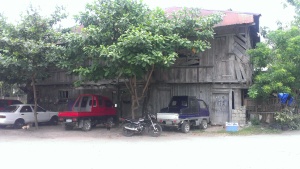“Adjacent to the Hontanosas House, the old YAP HOUSE is in a bad state of repair. Originally built by Don Carlos Yap, a prosperous merchant, it likewise dates back to the early or mid—nineteenth century, the heyday of Sitio Ubos (Luspo 2006). It has more in common with the Rocha-Suarez House, such as the wooden ground floor walls set on long strip foundations of coral stone. Unlike the latter, however, its first floor is accessed by an external staircase parallel to the front facade, leading to a long covered gallery in front of the upper floor, which stretches almost the entire length of the building. This is a very unusual arrangement for Boholano domestic architecture, and while the open gallery seems to be an original design, the current location of the staircase is possibly the result of a later remodeling. Behind the gallery, a barren simple main gate in the center gives access to the interior, with its traditional “hinges” and wooden lock. An unusual construction technique is the way the upper wooden façade is pegged to a roof beam above by use of small wooden pegs. Flanking the main door are symmetrical windows on both sides, some made of capiz, others consisting of plain wooden boards. The same layout is repeated on the ground floor, except that the windows are much smaller and protected by simple, vertical wooden slats. Although the exterior seems to be totally devoid of any decorative elements, the attentive observer will notice finely carved corbels on the upper floor very similar to the ones in the Rocha House and the Dauis convent. Other corbels can be found on the ground floor, although without – carvings. The Yap House has also retained its original roofline, albeit changed to galvanized iron sheets from its previous cover of probably nipa palm leaves. Small dormer windows on the roof for ventilation purposes add a particular charm to the structure. Unfortunately, the Yap house is in very bad shape; its wooden gallery has since largely collapsed, and the entire building shows all signs of worsening deterioration.”
Text from the book Casa Boholana: Vintage Houses of Bohol, by Erik Akpedonu and Czarina Saloma, 2011
